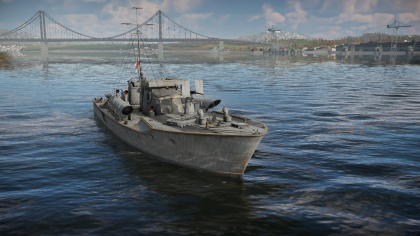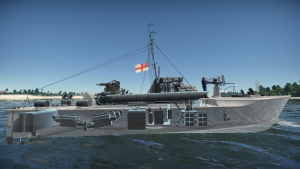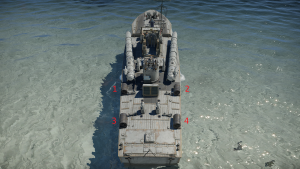Difference between revisions of "MTB Vosper(2)"
(Converted mobility to NavalMobility template; typos) |
m (Typo) |
||
| Line 26: | Line 26: | ||
* Superstructure: 15 mm, wood | * Superstructure: 15 mm, wood | ||
| − | While the gun | + | While the gun shield may stop low-calibre machineguns, heavy machineguns and cannons will have no trouble with them at any range. The hull and superstructure will not stop any sort of gunfire. |
{{PAGENAME}} can be hull-broken by any gun that is greater than 4 inches (102 mm) in diameter. Hull-break is triggered when any such gun hits and destroys any hull compartment — or in some cases, the bridge — with a high-explosive round, upon which the rest of the boat will be destroyed. At {{PAGENAME}}' battle rating, there is only one gun capable of hull-breaking her: | {{PAGENAME}} can be hull-broken by any gun that is greater than 4 inches (102 mm) in diameter. Hull-break is triggered when any such gun hits and destroys any hull compartment — or in some cases, the bridge — with a high-explosive round, upon which the rest of the boat will be destroyed. At {{PAGENAME}}' battle rating, there is only one gun capable of hull-breaking her: | ||
Revision as of 13:35, 24 October 2020
Contents
| This page is about the British motor torpedo boat MTB Vosper(2). For other versions, see MTB Vosper (Family). |
Description
The MTB Vosper 2 series is a rank British motor torpedo boat
with a battle rating of (AB), (RB), and (SB). It was introduced in Update 1.83 "Masters of the Sea" as part of the British fleet closed beta test.
General info
Survivability and armour
MTB Vosper(2) has the following armour layout:
- 20 mm/70 Oerlikon Mk.II gun shield: 12.7 mm, hardened armour
- Hull: 24 mm, wood
- Superstructure: 15 mm, wood
While the gun shield may stop low-calibre machineguns, heavy machineguns and cannons will have no trouble with them at any range. The hull and superstructure will not stop any sort of gunfire.
MTB Vosper(2) can be hull-broken by any gun that is greater than 4 inches (102 mm) in diameter. Hull-break is triggered when any such gun hits and destroys any hull compartment — or in some cases, the bridge — with a high-explosive round, upon which the rest of the boat will be destroyed. At MTB Vosper(2)' battle rating, there is only one gun capable of hull-breaking her:
- the 8cwt QF Mk I, found on Dark Adventurer.
The hull is split into three compartments. The first compartment starts at the bow and ends at the forward gun mount; the second ends in front of the aft gun mount, between the fuel tanks and the engines; and the third ends at the stern.
MTB Vosper(2) has one ammunition storage that holds ammunition for all gun turrets. It is located directly below the bridge, just above the waterline. Destroying it will instantly destroy the boat.
With a crew complement of 12, MTB Vosper(2)' overall survivability is average.
Mobility
| Mobility Characteristics | |||||
|---|---|---|---|---|---|
| Game Mode | Upgrade Status | Maximum Speed (km/h) | Turn Time (s) | Turn Radius (m) | |
| Forward | Reverse | ||||
| AB | Stock | 76 | 26 | ~23.68 | ~47.11 |
| Upgraded | 104 | 35 | ~16.33 | ~31.04 | |
| RB/SB | Stock | 64 | 22 | ~26.53 | ~53.95 |
| Upgraded | 74 | 25 | ~21.99 | ~43.75 | |
| Mobility Characteristics | |||||
|---|---|---|---|---|---|
| Game Mode | Upgrade Status | Maximum Speed (km/h) | Turn Time (s) | Turn Radius (m) | |
| Forward | Reverse | ||||
| AB | Stock | 76 | 26 | ~23.68 | ~47.11 |
| Upgraded | ~16.33 | ~31.04 | |||
| RB/SB | Stock | 64 | 22 | ~26.53 | ~53.95 |
| Upgraded | ~21.99 | ~43.75 | |||
MTB Vosper(2) has a displacement of 38 tons.
When moving at high speeds, either forwards or backwards, MTB Vosper(2) will drift slightly to starboard without any player input.
Armament
Primary armament
The primary armament consists of a single 20 mm/70 Oerlikon Mk.II mounted fore, with 1,980 rounds of ammunition available for it. Stock, the mount can traverse horizontally and vertically at a rate of 64°/s; with the "Primary Armament Targeting" modification installed, this is increased to 75°/s. The gun has a magazine capacity of 60 rounds and a cyclic rate of fire of 450 rounds/min. With a stock crew, the gun can be reloaded in 5.2 seconds; with an aced crew, it can be reloaded in 4 seconds.
| Primary Armament Guidance | |
|---|---|
| Horizontal | Vertical |
| ±180° | -10°/+60° |
There are three ammunition choices available:
- Universal: HEF-T · HEF-I · AP-T
- 20 mm HE: HEF-T · HEF-I · AP-T · HEF-I
- 20 mm AP: AP-T · AP-T · AP-T · HEF-I
| Penetration Statistics | ||||||
|---|---|---|---|---|---|---|
| Ammunition | Penetration @ 0° Angle of Attack (mm) | |||||
| 10 m | 100 m | 500 m | 1,000 m | 1,500 m | 2,000 m | |
| Universal | 35 | 33 | 26 | 21 | 18 | 15 |
| 20 mm HE | 35 | 33 | 26 | 21 | 18 | 15 |
| 20 mm AP | 35 | 33 | 26 | 21 | 18 | 15 |
Secondary armament
The secondary armament consists of two 12.7 mm Vickers Mk.V machineguns in a twin mount aft. There are 5,200 rounds of ammunition available for it, 2,600 rounds per gun. Stock, the mount can traverse horizontally and vertically at a rate of 64°/s; with the "Auxiliary Armament Targeting" modification installed, this is increased to 75°/s. Each gun has a belt capacity of 200 rounds and a stated rate of fire of 600 rounds/min, though in actuality, they fire at slightly different rates: the gun on the gunner's right side fires at a faster rate, around 685 rounds/min, firing all 200 of its rounds in the time it takes the left side gun to fire about 175 rounds. With a stock crew, the guns can be reloaded in 10 seconds; with an aced crew, they can be reloaded in 5 seconds.
| Secondary Armament Guidance | |
|---|---|
| Horizontal | Vertical |
| ±180° | -10°/+70° |
There are three ammunition choices available:
- Universal: T · AP · I
- 12.7 mm I: T · I · I · I · I
- 12.7 mm API: T · AP · I · AP
| Penetration Statistics | ||||||
|---|---|---|---|---|---|---|
| Ammunition | Penetration @ 0° Angle of Attack (mm) | |||||
| 10 m | 100 m | 500 m | 1,000 m | 1,500 m | 2,000 m | |
| Universal | 24 | 24 | 21 | 18 | 16 | 15 |
| 12.7 mm I | 20 | 19 | 16 | 14 | 12 | 11 |
| 12.7 mm API | 24 | 24 | 21 | 18 | 16 | 15 |
Torpedo armament
MTB Vosper(2) can carry two 533 mm Mk.VIII torpedoes. The torpedo tubes are located on either side of the bridge, pointing forwards with the nose angled outwards.
| Torpedo Characteristics | ||||||||
|---|---|---|---|---|---|---|---|---|
| Torpedo Mode | Mass (kg) | Maximum speed in water (km/h) | Travel distance (km) | Depth stroke (m) | Arming distance (m) | Explosive type | Explosive mass (kg) | TNT equivalent (kg) |
| No | 1,566 | 50 | 4.57 | 1 | 50 | TNT | 327 | 327 |
| Yes | 76 | 6.40 | ||||||
The Torpedo Mode modification is available as a rank IV modification. Installing it will give the following changes:
| Torpedo Mode Specification Changes | |
|---|---|
| Max Distance (m) | Max Speed (m/s) |
| +1830 | -1 |
Special armament
MTB Vosper(2) has four possible loadouts:
- 2x Mk.VIII torpedo
- 4x Mk.VII depth charge
- 2x Mk.VIII torpedo, 4x Mk.VII depth charge
- Without load
The Mk.VII depth charges are carried around the bridge area, three on each side. They are dropped one at a time in the following order:
- Port, foremost
- Starboard, foremost
- Port, aftmost
- Starboard, aftmost
Before spawning, the detonation time delay can be set anywhere between 3 seconds and 10 seconds.
| Depth Charge Characteristics | |||
|---|---|---|---|
| Mass (kg) | Explosive Type | Explosive Mass (kg) | TNT Equivalent (kg) |
| 196 | TNT | 130 | 130 |
Usage in battles
Vosper 2 series is the first British boat to come equipped with the 20 mm/70 Oerlikon Mk.II cannon, a common weapon in both the British and US naval tech trees. It is a very good weapon and a nice change of pace from the low-calibre machineguns of previous vehicles. The most direct comparison to the Oerlikon Mk.II cannon would be with the 2 cm/65 C/38, another common cannon. Compared to the 2 cm/65 C/38, the Oerlikon Mk.II has lower per-hit damage and a slightly lower rate of fire but makes up for it in having a much larger belt capacity, 60 rounds compared to the 2 cm/65 C/38's 40 rounds. As for the secondaries, the two 12.7 mm Vickers Mk.V machineguns together are actually quite a lot better than the Oerlikon Mk.II cannon; they have a slightly higher damage output and, more importantly, can fire for much longer before reloading. However, using the Vickers Mk.V guns requires exposing the rear hull compartments, dramatically reducing the survivability. Both armaments can't be manually controlled at the same time, so it's best to simply just pick one and stick with it, the choice of which to use largely being dependant on your own playstyle: use the Oerlikon Mk.II for safer and more consistent gameplay; use the Vickers Mk.V if you prefer greater offensive capability at the cost of survivability.
If you prefer the Oerlikon Mk.II, try to always keep the hull pointed towards the enemy in order to block the rear hull compartments with the bow compartment. Vosper 2 series' crew is spread out in such a way such that all three compartments must be destroyed to knock it out, not including damage to the bridge, which makes bow-tanking a viable strategy, especially since the ammunition storages are located far enough back to not be much of an issue. Of course, angling the hull like this means the Vickers Mk.V guns won't be able to fire, but since they will be controlled by the AI gunners, it's best to leave them targeting aircraft and forget about them. On the other hand, if you prefer the Vickers Mk.V guns, know that the aft gun mount can fire in all directions except ~23° to either side facing forwards. Try to angle just enough so that the Vickers Mk.V guns can fire, and no more than that to minimize showing the sides as much as possible. Since the Oerlikon Mk.II can still fire while using the Vickers Mk.V guns, let the AI gunners target surface targets as well as aircraft.
Whatever playstyle you prefer, be flexible and always be prepared to switch to the other guns in a pinch, such as during reloads, in case one of them is knocked out, and so on. Additionally, with either gun, fire off any remaining ammunition after engagements if there isn't much ammunition left in the magazines. For the Oerlikon Mk.II, this is when there are about 30-40 rounds left, and for the Vickers Mk.V guns, it is when there are about 200 rounds left between the two. While the reloads for both guns aren't particularly long, it's better to avoid being forced to reload in the middle of an engagement in the first place.
- Ammunition Choices
For both the 20 mm/70 Oerlikon Mk.II cannon, the best ammunition choice is the 20 mm HE belt because it has the highest ratio of HE rounds to AP rounds, which means that it's the most effective against both aircraft and the vast majority of surface targets. While the HE belt should be the main ammunition, a few 20 mm AP belts should also be taken for use against armoured targets. The AP belt is also useful for damaging internals and hull compartments that are blocked by already destroyed compartments.
For the 12.7 mm Vickers Mk.V machineguns, the 12.7 mm I belt has a noticeably higher damage output than both the Universal and 12.7 mm API belts, both of which are about the same in terms of damage. Because it lacks the AP round, the 12.7 mm I belt has slightly less armour penetration than the other two belts, but in general, anything that can stop the incendiary round will also stop the armour-piercing round. Take only the 12.7 mm I belt and switch the Oerlikon Mk.II to deal with armoured targets.
- Torpedoes
The Mk.VIII torpedoes are a decent torpedo with above-average top speeds and warhead size. Its maximum range is more of less average compared to other torpedoes at this tier.
The Torpedo Mode modification should never be installed. The higher maximum speed is much more valuable against the small and fast boats of tier I and II, and the 4.57 km maximum range with the Torpedo Mode modification uninstalled is more than enough for the small maps.
Be aware though that, unless already launched, the torpedos can be shot at, and, if it's destroyed, there is a chance for them to detonate. For this reason, it's best to either use them early on or to not take them into battle at all. Torpedoes are a situational weapon, so it's largely down to personal preference whether you want to take them or not.
- Depth Charges
There is no practical reason to use depth charges on any naval vessel in the game. Although they usually result in a one-hit kill if used properly, they are extremely situational and are actually a liability in most cases. This is because, unless they're dropped, they essentially act as exposed ammo racks.
With some luck, sailing up right next to a slower target and dropping a depth charge can lead to some success. If attempting this, remember the depth charge drop order and that there is no reason to set the depth charge delay above the minimum 3 seconds, since a higher delay time means that the depth charge will only sink further, and thus away, from the target. Again, this is extremely situational.
The recommended loadouts are, depending on personal preference:
- 2x Mk.XII torpedo; or
- Without load
Modules
| Tier | Seakeeping | Unsinkability | Firepower | |||
|---|---|---|---|---|---|---|
| I | Dry-Docking | Tool Set | 20 mm HE | 12.7 mm I | ||
| II | Rudder Replacement | Fire Protection System | Smokescreen | 20 mm AP | 12.7 mm API | Auxiliary Armament Targeting |
| III | Propeller Replacement | Depth Charges | Primary Armament Targeting | |||
| IV | Engine Maintenance | New Pumps | Artillery Support | Torpedo Mode | ||
Pros and cons
Pros:
- Strong armament, great damage output
- Good manoeuvrability
- Good torpedoes: above-average maximum speed and explosive charge
Cons:
- Relatively low survivability
History
During the 1930s, the Admiralty tried to reestablish the coastal boat flotillas it once commanded during the First World War. British boatbuilding company Vosper & Company competed for the contract but lost both times in 1935 and 1936, the lucrative contract to build the first coastal boats since WWI going instead to their rival, British Power Boat Company. In response to this, Vosper developed a faster and more seaworthy design than that of their rivals'. In the following months, Vospers proposed their design to the Admiralty multiple times, but ultimately, they could not secure a contract to build a prototype. Around this time, though, the Admiralty officials had unofficially suggested that future contracts would only be awarded for vessels that could surpass 40 knots in speed and that were armed with two 21-inch torpedoes as well as an assortment of light anti-aircraft guns. Additionally, it was known from previous specifications that the Admiralty wanted a vessel capable of operating in open waters in at least Force 5 winds and that was fast enough to cross the English Channel during the night. With these unofficial specifications, Vospers preemptively began development on a new vessel as a private venture of the company's own expense.
Immediately, it was decided that the private venture vessel had to be larger than the existing 60 ft British Power Boat MTB in order to meet the specifications. Additionally, engines more powerful than the Napier Sea Lion engines used in the BPB design were required. With none available domestically, Vospers looked to the Asso 1000 engine by Italian manufacturer Isotta-Fraschini. Though in limited supply, the Asso 1000 was specifically designed for marine craft and provided the necessary power: 1150 bhp at 1500 rpm maximum and 950 bhp at 1660 rpm continuous. In late 1936, Vospers completed their design. It called for three Asso 1000 engines and two in-house 75 bhp auxiliary engines, the latter of which could be coupled to the outer shafts to give a total maximum power of 3600 bhp. The hull-form was a hard chine planing design and was 69½ ft in length with a displacement of about 33 tons. The prototype was laid down before the end of the year and completed in May 1937.
Upon completion, the prototype underwent internal trials where she achieved a top speed of 47.8 knots unloaded and 43.7 knots loaded. Satisfied with these results, Vospers presented the prototype to the Admiralty for official trials against the 60 ft British Power Boat MTB. The prototype fared favorably, and after much deliberation, the Admiralty decided to purchase the vessel from Vospers. She was commissioned in May 1938 as MTB 102 and sent to HMS Vernon for further evaluation. Up to this point, MTB 102 had not actually been fitted with torpedoes, so during her time at HMS Vernon, many torpedo configurations were tested. These included tried-and-true yet outdated stern projection systems as seen on the 60 ft British Power Boat MTB and earlier WWI designs as well as a unique arrangement of a single launcher in the stem of the hull with a reload carried internally. These all had their own issues, and none were found to be satisfactory. Ultimately, it was decided that MTB 102 should have two torpedo tubes mounted on either side of the bridge, pointed forwards with the nose angled outwards, an uncommon configuration for the time. Around this time, the gun armament had also not yet been decided, so various configurations were also experimented with, including combinations of 0.303 in and 0.50 in machineguns and a 20 mm autocannon.
Impressed with MTB 102, the Admiralty placed an order for four more vessels on 15th August 1938, Vospers' first-ever Admiralty contract. These vessels, and any ordered after, all shared the same overall design as MTB 102, although with several minor changes such as the hull being lengthened to 70 ft 3¼ in. After 1940, with the entrance of Italy into the war, Isotta-Fraschini engines could no longer be obtained, and subsequent boats had to be fitted with much weaker American Hall Scott engines — only 1800 bhp total — as a stopgap measure until they could be upgraded with more powerful Packard engines, though this wasn't until 1941 as supply was limited. Of the 32 planned 70 ft Vosper MTBs, 28 were completed and are as follows:
- MTBs 20-23: Ordered 15th August 1938, all were completed by December 1939. MTBs 20, 21, and 23 were sold to the Romanian Navy. MTB 22 served with the 4th MTB Flotilla and survived to the end of the war and was sold in 1945.
- MTBs 29-30: Ordered on 8th September 1938 (including a Thornycroft design, MTB 28) as replacements for the three boats sold to Romania, all were completed by July 1940. Both MTB 29 and 30 served with the 4th MTB Flotilla. MTB 29 was lost in a collision with a German E-boat on 6th October 1942, and MTB 30 struck a mine and was lost on 18th December 1942.
- MTBs 31-40: Ordered on 27th September 1939, six were completed by May 1941. MTBs 33, 37, 39, and 40 were bombed by German aircraft while under construction in 1940-41. The completed boats survived to the end of the war and were sold in 1945-46.
- MTBs 57-66: Ordered on 26th February 1940, all were completed by April 1942. MTB 61 was stranded during an attack on 9th May 1943, and MTBs 63 and 64 were lost after collisions with friendly MTBs on 2nd April 1943. The remaining boats were sold in 1944.
- MTBs 69-70: Ordered in April 1940, both were completed by June 1940 and received only two engines. Both were stationed at HMS Beehive, Felixstowe and survived to the end of the war and were sold in 1945-46.
- MTBs 218-221: Ordered on 7th December 1940, all were completed by September 1941. MTB 218 struck a mine and was lost on 18th August 1942, and MTB 220 was sunk by German E-boats on 13th May 1942. MTBs 219 and 221 survived to the end of the war. MTB 221 was sold in 1945, and MTB 219 was transferred to the Sea Cadet Corps at Staines in 1945 and was converted to a houseboat in 1948.
The 70 ft Vosper MTB design continued to receive many improvements and modifications order-to-order and would lead to the development of the 72 ft Vosper MTB and 73 ft Vosper MTB.
Media
See also
External links
- Coastal Forces Veterans - Boat Database
- ww2ships.com - 70' Vosper Motor Torpedo Boat
- unithistories.com - Royal Navy Coastal Forces 1940-1945
- naval-history.net - British vessels lost at sea in World War 2 - MGB, MTB, SGB, ML, etc - originally published in British Vessels Lost at Sea, 1935-45, His Majesty's Stationary Office, 1947
Bibliography
- Lambert, J., & Ross, A. (1993). Allied Coastal Forces of World War II Volume II: Vosper MTBs & U.S. Elcos (pp. 21-32). London, England: Conway Maritime Press. ISBN 0-85177-602-7.
| Britain boats | |
|---|---|
| Motor torpedo boats | Brave Borderer · Dark Aggressor · Dark Aggressor TD · Fairmile D (617) · Fairmile D (697) · Fairmile D (5001) · HMS Gay Archer |
| MTB-1(1) · MTB-1(2) · MTB Vosper · MTB Vosper(2) · MTB-422 | |
| Motor gun boats | Dark Adventurer · Fairmile A (ML100) · Fairmile B (ML345) · Fairmile C (312) · Fairmile C (332) · Fairmile D (601) · Fairmile H LCS(L)(2) |
| HMAS Arrow · HMAS Fremantle · MGB-61 · MGB-75 · ML 1383 · SGB Grey Fox · SGB Grey Goose | |
| Gunboats | HMS Spey |








